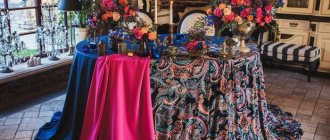Wedding in India - like in the movies? No, this is Indian cinema - almost like a wedding!
Look into those eyes and maybe you will understand why Indian grooms save themselves for the one and only. She's beautiful!
What kind of guy is there, an adult and mature man of about 34 years old, saving himself for his one and only. Don't believe me? Is it true. You say: well, why such details, we are not Indians, we just want to make a stylized wedding evening. So here it is; the wedding will not be completely “Indian”, no matter how luxurious the surroundings are, until you are imbued with a special spirit of chastity, the joy of finding each other and faith in an endless happy future. In India, you see, there is no other scenario: divorces are very, very rare. It is not customary to exchange an old wife for a young beauty.
An Indian wedding is a celebration of a lifetime!
An Indian wedding is a grandiose celebration, a coveted moment that is anxiously awaited for decades (until the money is collected, and until the bride is wooed). They prepare seriously for the first night, guests are invited - half of Mumbai! Before choosing flowers, decorations and setting tables, be imbued with this exciting anticipation of the unity of flesh and spirit for the rest of your life. Ready? Well, then let’s start the wedding “Indian style.”
Getting married in India is crazy. I got through it. (Photo and video)
Valery Kravtsov from Latvia gives an interview, who recently married his daughter to the son of a former poor peasant, and now a rich Indian landowner:
Valery Kravtsov: — A wedding in India is some kind of madness. When a Hindu man's daughter is born, he starts saving for her wedding. At the same time, you don’t really have to feed your daughter or teach her. They will collect a lot of money, spend it all on the wedding, and then the daughter may again live from hand to mouth and not study.
Yuri Alekseev: - What is the price order there?
— In Delhi it’s more expensive than in Moscow. I asked the Speaker of the Delhi Parliament: why is it so expensive for you? He says: Valera, Moscow is a small city. And in Delhi there are only 20 million counted residents, plus the same number of uncounted ones. Plus the suburbs - there are just as many more. In India, three years ago there was a census, they counted 1.2 billion and stopped counting - they got tired. They do not limit the birth rate, like the Chinese. — Where did your boyfriends meet?
— They studied together in England, in Cardiff, at the university. Diana is a lawyer, and Rahul is a mechanical engineer. - Will he feed his wife?
- Well, they have their own land, he will work for himself, they build apartment buildings and rent them out. They are rich people, because in Delhi land is the most valuable thing.
-What kind of poster is this?
— When we were driving around Delhi, I suddenly discovered such posters in the area where the wedding was taking place. In India, this is a generally accepted practice, not an invitation, but a kind of information that such an event will take place.
— Do the guests come by invitation or the whole family, who found out about the event?
- Yes, by invitation only. They sent out thousands of them. Both by mail and couriers...
- This is the first ritual - betrothal. In principle, the engagement should take place one year before the wedding. But since we are Europeans, they made an exception for us and got engaged just 10 days before the wedding.
Sagay - meeting the family
- This is the next ritual - Sagai, three days before the wedding. Its purpose is to introduce families. Here we are accepted into the family of the groom - Solanki. All men of the clan, all important figures, come to the ceremony. Here I am among Indian politicians. In India it is very easy to spot a politician. If a person is wearing a brown sleeveless vest, he is a member of the state parliament. And if the sleeveless vest is light-colored, this is a member of the municipal parliament.
- And they walk like this everywhere?
- Yes, apparently they don’t harm the people so much that they walk around fearlessly in their parliamentary uniform. And in a turban - the elder of 360 villages, where 4.2 million people live. He, as I understand it, is the elder in the family.
“And here is part of my new family on the male side.” All of them were not included in the frame; there are just as many on the right. In front of me in such a shabby cap is a brahman. He leads the ritual. And opposite, in a gray suit and cap, is the oldest man in the family. - What's going on there?
- At the moment I am giving gifts to the groom and his relatives. According to the ritual, you need to give clothes and food (fruits) to close relatives. Then everything for the men of the family is money. - Everyone?! There are hundreds of them! Aren't you broke?
- No, this is a purely ritual matter, the size of the gift in terms of our money is about 5 lats. But - everyone! There were about 250 people there in total. — How did you understand what needed to be done there? Do you know Hindi?
- Of course not. But the evening before, a brahman came to our apartment and gave instructions. Where to go, who to give what first, in short, I wrote out the whole procedure. Well, he helped along the way. In general, all of their procedures are simple, everything is very clear, humane and friendly.
But although with smiles, although democratically, this event - Sagai - was the most serious and widespread. It was here that there were 3.5 thousand guests. It is considered even more important than the wedding itself. Here everyone is looking at you, because you are pretending to become related to them. How you enter the family determines how the family will treat the bride. Moreover: as I understand, on Sagai they may not be accepted into the family. —What did you look at most?
- You will laugh, everyone looked very closely at my lapel badge - such a small red “Concord Center” badge, in the bustle I forgot to unfasten it from my dress suit. For Hindus, even the smallest detail always carries a special meaning. So everyone asked me: is this an order? I answered: yes, this is the Order of Concord! (Laughs.) - Were you asked or examined about something there?
— No, but they looked at the gifts very carefully, they even copied and photographed them all. - What are women doing at this moment?
— There are tables set behind the pavilion, women are having fun with the guests. But there is no bride, no one should see the bride before the wedding. And my wife didn’t go either - she was scared. The event is too serious: it starts at 12 noon and ends at 10 pm. To be honest, I myself could only hold out until five. When the “official part” ended, I went home.
Henna night - bachelorette and bachelor parties
- This is the day before the wedding - the so-called “Henna Night”. What’s the trick: all women have their hands painted, and the bride’s feet are also painted:
— This is a purely youth event, a bachelorette party and a bachelor party. Usually girls walk separately, boys walk separately, but for us, as Europeans, they were combined.
- These are the patterns made from henna. It is believed that the brighter the pattern is, the longer it does not fade, the better the relationship between the bride and mother-in-law will be. Henna lasts for about a month. - Such a complex drawing... How long does it take to paint?
- About an hour. The bride is painted by two artists who work very quickly. The pattern makes sense. Let's say the Solanki family has two peacocks on their family coat of arms, so they depicted them on their legs. And the rest of the women apply small patterns to themselves:
- These are painted women. From left to right: geography - Shanghai, Brussels, Liepaja (my second daughter), St. Petersburg, Liepaja (my wife). The rest are bridesmaids.
- This is what a fresh drawing looks like. Women must sit still for two hours and dry off.
- And while women are drying, men are soaking...
Wedding town
— And this is the main entrance to the wedding town. An entire city is being built there for one wedding.
- These are lodges for elders...
“And this is the central tent for family members.” It is all draped with fabric, I was told that the amount of fabric was gone - 23 kilometers! - 23 kilometers! Have you ever wondered how much it all cost them?
- Well, why weren’t you interested? I even contributed to the expenses, but only contributed a small portion. I won’t say how much, I won’t scare our little Latvia. - And below is a carpet?
- No, grass! And this grass is almost the most expensive thing at the whole wedding. In Delhi itself, such a piece of free land costs a lot of money. And those who own such land are the true rich. They rent it out for weddings and have a lot of money. They earn 8 million pounds per season on such a piece.
“And this is a special pavilion only for congratulations, showering the newlyweds with flower petals and taking photographs. Photo pavilion in our opinion.
— And this is a covered pavilion awaiting guests.
The wedding itself
— According to tradition, the groom rides on a white mare to meet the bride. It is on the mare that this personifies the dominance of the male over the female.
— The men of the family dance in front of the groom, urging him to come to his senses - don’t do this! They dance for two hours so that they can think carefully. They even offer money so as not to marry.
- And this is the meeting of the groom with the bride’s women. In the center is my future mother-in-law, on the left in blue is my second daughter, then my mother. On the right are the bridesmaids.
— The future mother-in-law draws a red dot on the groom’s forehead to indicate that he belongs to Hinduism. And he sticks several grains of rice on this point - this is an analogue of the Russian “bread and salt”. And he hands over a plate with various dishes on it, symbolizing abundance. - And there are still matches there - does that make sense too?
- Yes, the groom then passes the cup to the brahman, who uses these matches to light the family hearth.
— The groom is ready, waiting for the bride.
- Now we take the bride to the groom. On the left in a tuxedo is my youngest son.
—Where did you get the saris for women?
- Oh, this is interesting. The groom's relatives asked us: do you want to wear a European dress or a sari? My women are brave, they wanted to wear a sari. The rest did not dare and later regretted it. Because everyone was given a sari, and it turns out that the sari also came with jewelry - they were given that too. (Laughs.)
- The bride is ready! Six kilograms of jewelry - family jewels. These jewels are passed down from generation to generation from the groom's mother. They are old, their gold is not ours, it is pure, so yellow, dull and soft. The sari on the bride is also a fortune, all the embroidery is extremely complex, handmade.
“Did her nose get pierced too?”
- No, it's pinned. By the way, about the jewelry. Some of them are real, and some were replaced with costume jewelry. That is, they gave them real ones, but when they dressed them up for a wedding, they replaced the most expensive ones with “counterfeits.” They explained that wearing too expensive things in a public place is simply dangerous. They immediately said: it’s better not to wear this, this is something you can wear, but this one needs to be put on. There is some kind of protocol there.
- And here is the connection between “fragile Europe and mighty India.” Here they were brought together, they put garlands of fresh flowers on each other - and then the process of photographing began. Three hours - with each other, with guests, receiving gifts. But they are not husband and wife yet. The ceremony itself has not yet taken place; this is, as it were, their “first acquaintance.”
— Photo with the groom's parents
- And this is the union of the fathers of the bride and groom - Ramesh Solanki and Valery Kravtsov.
— Does the groom’s father have a wallet in his hand?
- Exactly! He walked with it like that, endlessly opening and paying with this and that. He was the main manager. Moreover, he very often called me over and gave me some amount and said: I need to give it to this or that. Again - according to wedding protocol.
— Valery, admit it, you didn’t feel like a poor relative there?
- Yes, I realized that according to their concepts, we are beggars. What saved me was that I served a year in the Seimas. And I was introduced to everyone as an ex-member of parliament. And for them, a member of parliament is practically a living god. They measure it against their own country, with a population of one and a half billion... My job was to remain silent and pretend to be important. (Laughs.)
- And here is the ceremony itself. The newlyweds make seven vows to each other, three vows for the groom and four for the bride. Three oaths are kind of standard, like ours: to be faithful, not to leave in trouble, and so on. And the additional, fourth vow of the bride is wonderful. It sounds something like this: “I will never allow myself to shout at my husband in public . It would also be nice for our women to introduce such an oath. (Laughs.)
- But this is the most important point. The groom's father took off the gold ring, gave it to the groom, who scooped up red paint with the ring and applied it to the bride's parting. A part in the hair, painted with red dye, means a married woman. It is at this moment that she becomes his wife. — By the way, does your daughter speak Hindi?
“She already speaks a little, it’s her fifth language.” She will learn, languages are easy for her, unlike me. She will now live in Delhi.
“And this is the brahman who tied them up, and they walk around the hearth seven times.” The bride leads three circles and the groom leads four circles.
— The wedding ceremony is over, the bride and groom again go to their “photo pavilion,” and the elders, the brahman (who is wearing a brown cap), the groom’s father and we sit down and begin to give us gifts. On Sagai we gave gifts, but here we were given gifts. They give you the same jewelry that they said you shouldn’t wear.
—Have you at least assessed them in any way?
- Yes, when? There was no time for that. I accepted it in boxes and gave it to my daughter in boxes.
- But the guests are having a snack. This part of the table is vegetarian. It’s interesting that, according to our tradition, the bride and groom are at the head of the table, with all the guests around them, but in India it’s completely different. A whole city has been built for the guests, they eat, drink, have fun there, but the bride and groom are in one corner, the parents are in the other, no one sees or bothers them. Honestly, I liked it - no need to jump around like a toastmaster. — By the way, how did Indian food taste to you?
— It is quite simple, peasant, almost like Latvian. We have gray peas, and their favorite beans are dal, which they prepare in different modifications. Of course, everything there is spicy - even ice cream comes with pepper and tea with pepper... It suits the hot weather. The main thing is not to drink their water. And to be honest, until I pour whiskey on top of their vegetables, my stomach doesn’t work on Indian vegetarian food. - Vodka is better for the Russian stomach...
- Of course, but I gave away all the vodka that I brought. — The wedding, as I understand it, was non-alcoholic and traditional. Do they themselves use it in civilian life?
- Very little. Indians do not have the resistance to alcohol that we, the northern peoples, have. They take two sips and they go crazy. They drank a few times and became alcoholic... So it’s better for them not to drink at all.
“The wedding is already over, the newlyweds are put in the car, but the bride is accompanied to her husband’s house by her brother and sister on her wedding night. The newlyweds do not sleep together on the first night; her close relatives are nearby with the young wife. On this night, the wife’s task is to get to know her husband’s house. Previously, according to tradition, the bride could not enter the house of her future husband at all before the wedding.
The next day, the young wife is picked up by relatives and brought to her parents’ house, where she must tell what she saw in her husband’s house. And already on the second night, the husband takes the young wife to him for good.
— And this is the Solanki family street in Delhi, about 25 houses. The street is closed with gates, guards with guns stand at the gates, and even guard dogs are let loose at night.
Street video:
- Stones of India - emeralds, rubies... This does not apply to the wedding, but on the IMHO club forum they asked me to talk about the stones. We visited a family of jewelers who cater to the Solanki family. When they showed these treasures, there was such a small Indian standing behind me with a huge “arquebus” - a barrel four centimeters in diameter. (Laughs.)
— Did you find out any details about the family you became related to? How did you get rich?
— On Russian military equipment.
— ???
— 20 years ago, Russia supplied a lot of military equipment to India, and the groom’s father was then a simple peasant. But by some twist of fate, he ended up at the airfield to work as a mechanic servicing MiGs. I took some courses as a general mechanic. But at that time, the peasants lived in complete poverty, and the mechanic received decent money - simply fantastic for a village. And he used them wisely - he began to buy land. And to be honest, I even overdid it. He bought too much of it, and when Delhi expanded to their village, the government couldn’t even buy all the land from him. It took away part of the land - bought it for pennies, but part of the land remained with it. And this land is now a huge fortune. But this condition began precisely with Russian military equipment.
And lastly: elephants, where would India be without them?
source
And a similar video on the topic:
Recommended viewing:
Child marriage: heartbreaking wedding photos of a 15-year-old girl
How it works. A real Indian wedding. (+doc. film)
Indian wedding (photo report)
We write wedding invitations in Indian style
Such a luxurious invitation is difficult to send to all guests; but the most expensive ones - why not?
You can make your wedding invitation traditional; the only reminder of the color will be the design. Thick, satin paper, floral patterns in gold, red, rich green and dark blue are welcome. The more gold the better. In India, especially honored guests are sent invitations on silk scrolls in special boxes. You can put the postcard in a special cardboard box or a thick cardboard envelope - this will also be very Indian.
Doesn't it look wonderful? Such invitations are pleasant to send and pleasant to receive. It is immediately clear what kind of wedding you are invited to and what you should give.
But if you want to maintain the style 100%, then you need to use invitations also as a reminder, a warning: dear guests, the wedding will not be just any wedding, but an Indian one. Come in a sari and give elephants to the newlyweds. Everything will be like in Bollywood!
Castes
There are four castes (in order of increasing social status): Shudras, Vaishyas, Kshatriyas and Brahmins. But the castes are actually much larger, several thousand (due to numerous subcastes). In fact, as many professions (social units) as there are castes. Each profession is classified according to the main four, acquiring the status of podcasts.
The caste system has been followed for thousands of years, and therefore people in castes differ in appearance. People from the upper caste are usually tall with beautiful faces and lighter skin. The lower ones are short with flat noses and very dark skin. They even have different diseases.
It is known that vaishyas (traders) are often allergic to anesthesia. We just noticed that some patients on the operating table die for no reason. They conducted a study and it turned out that it is patients from the Vaishya caste who most often suffer from allergies to anesthesia. Since then, in modern surgery in India, before the operation, the genetic affiliation to a particular caste is determined, and if the patient is a Vaishya, then the dose of anesthesia is reduced to a minimum.
In general, four castes (varnas) correspond to four areas of social life: laborers and servants, merchants, managers and clergy. There are also untouchables, these are primarily those who are engaged in tanning leather (work associated with corpses is considered unclean) and laundresses. In modern India, at the legislative level, discrimination based on caste is criminally punishable. Now, theoretically, any person from any caste, having the necessary qualities, can get any job. True, in practice this is not always observed, especially in villages.
The groom's turban and the bride's dress, red as a pomegranate flower...
The next important point is the outfits of the newlyweds.
Purple and gold are the main colors for the bride and groom at an Indian wedding.
What you should pay special attention to is the groom's suit. His outfit is no less beautiful than the bride’s!
A gold-embroidered kurta-paijama suit (similar to a prince's camisole) and a turban are very, very masculine, beautiful and... sexy.
The traditional costume of the Indian groom is in no way inferior to the wedding dress of the bride!
The traditional color of a wedding sari is bright red. For a sari, take a piece of fabric 5-9 meters, in one piece. They are wrapped in a special way: first, like a skirt, they wrap around the hips (starting from the left side), then the remaining end is pinned on the left shoulder.
Wearing an Indian wedding sari is not just about zipping up the skirt.
The main secret of the sari is the folds; you need to model them yourself during the “wrapping” process.
The process of dressing in an Indian sari is the whole art of folding fabulous fabric...
Under the sari, a short blouse like a T-shirt and a lehnga underskirt are worn.
Traditional wedding attire of Indian bride in gold.
But... our wedding is still “in style.” Therefore, it is possible to deviate from traditions. And from the scarlet sari.
Sometimes Indian brides themselves abandon the red wedding sari in favor of a white dress with a veil...
Even if the bride is not wearing a sari, she needs a cummerbund belt (gold or silver, very elegant). Traditionally it is worn on the hips, but if the style of the dress requires it, it can also be worn on the waist.
But any other color of a wedding sari is in no way inferior in colorfulness to traditional red!
What should definitely be present in the outfit is an abundance of gold and jewelry: a “tika” pendant on the forehead, a haar necklace on the neck, and karn phool earrings on the ears.
A bride's wedding look would not be complete without luxurious Indian jewelry!
Don’t forget to wear bracelets: above the elbow – bajubankh, on the wrists – red chudiyan. And I soldered many, many silver bracelets with bells on my ankles.
It’s amazing how they do it: they put on a lot of makeup, but nothing tasteless or provocative! And tika, haar and karn phool are amazingly good! Perhaps it's all about amazing harmony and strict adherence to style?
Makeup should be brighter than usual wedding makeup: kajal or anjana eyeliner is applied to the eyes. The lips are painted so that they look plump and soft, and the eyebrows are dark and clearly defined, hair to hair.
But in general, wedding makeup should be in harmony with the bride’s wedding image.
Yes, a nose ring with a chain to the ear is also a must for an Indian bride. True, before deciding on such an exotic, you should think carefully.
Not every bride dares to achieve such beauty...
The bride's bouquet is always red, and only red! These could be purple roses, scarlet carnations or crimson orchids. White flowers in the hair (wedding braid) and just garlands on the shoulders and neck are also required...
Red color in Indian culture is the color of good luck and happiness, prosperity. Therefore, the bride can only have red flowers in her hands.
Models of modern Indian wedding dresses
Western influence has made some adjustments to the wedding look of Indian women: some girls, instead of the classic red or green sari, decorated with a wide embroidered border, wear clothes of a different shade or models close to popular European styles. Despite these changes, Indian newlyweds manage to preserve the unique features inherent exclusively to their culture, and therefore even the usual classic dresses made by brides from India acquire unusual shapes, original shapes, and original decor with beautiful embroidered designs.
Short sleeve mermaid silhouette
Not only Indian, but also European designers noticed the huge potential of the national women's costume - the sari looks rich, elaborate, and can decorate a girl at any large-scale celebration. Perhaps this is precisely what led to experiments with the shape of this outfit: as wedding decoration, girls began to wear Indian attire made in the style of a mermaid dress. A tight-fitting model, flared from the knees or below, looks great, emphasizes the ideal figure of the bride, and the incredibly beautiful decor of the outfit makes it solemn and majestic.
Dress – sari
A wedding sari is always distinguished by particularly rich decor, an abundance of gold embroidery and decorations. Modern Indian brides can choose bright red, green, blue, purple dresses for the event, as well as more delicate shades - white, cream, light yellow. This image will be complemented by a piece of embroidered fabric that matches the tone of the sari - a wedding celebration is rarely complete without it. If the bride decides to make the wedding in Indian style completely themed, then wearing a national women's costume of India instead of a classic dress is an excellent solution.
Dress made of embroidered fabric
The hero of the occasion does not need to be completely immersed in Indian culture to highlight the style of the event, so you can choose a familiar white dress embroidered with beautiful patterns. This can be a traditional design typical of Indian clothing, or any other design that the newlywed will like. Dresses that are embroidered with gold or silver threads, decorated with shining rhinestones, pearls, and semiprecious stones are suitable.
Wedding dress with full skirt
For a fluffy dress, the newlywed can choose colors typical of Indian dresses - these are bright shades of red, green, blue, yellow, purple, pink, orange. Belonging to Eastern culture can be emphasized by appropriate decor - embroidered patterns, stones, rhinestones, as well as a special cut. For example, the hero of the occasion can choose a dress with a strap or loose sleeves on one shoulder, which will visually have a slight resemblance to a tied Indian sari.
Guests' outfits will help create the ambience of an Indian wedding
Offer colorful traditional sarees for your girlfriends at your wedding!
Bridesmaids will be delighted at the prospect of wearing exotic Indian silks.
The secret of mehendi and the image of the bride at an Indian wedding
According to tradition in India, on the eve of the wedding, the bride gets mehendi - a henna tattoo. We need to make a clarification: the groom also gets mehendi done. And this is a very important point. It is believed that the more drawings are applied, the richer the openwork ornament, the happier the life awaits the newlyweds.
Perhaps the harmony of future relationships is programmed in the exquisite lines of the mehendi pattern?
Henna has healing and cleansing properties and special energy. Typically, mehendi is applied to the palms and arms up to the elbow (something like painted gloves), feet and ankles. Why palms? – This is probably not accidental; Fate draws its lines on the palms; here is the reflection of all seven chakras. The same can be said about the feet.
Henna designs cover not only the hands of an Indian bride, but also her feet.
Mehendi relaxes and promotes relaxation; the procedure takes almost the whole day. Do you know what bridesmaids and bridesmaids talk about all this time in India? – About sex; about the first wedding night; about the secrets of a happy marriage. All the remaining henna is “painted” on friends; everyone should have enough happiness on this day!
There should be plenty of happiness for all the bridesmaids on this day!
Previously (and in some Indian nations even now) a small white spot was left in the center of the palm; It was these white circles that connected the bride and groom during the marriage ceremony. What is happening at this moment? – Energy exchange, invisible energy bonds arise? Maybe the secret to the longevity and strength of Indian marriages lies in this tattoo? Who knows who knows. You decide.
Interesting facts about Indian wedding
- Chastity of the bride.
According to the Hindu worldview, a woman is an open field. The male husband must be the first to touch this virgin land, grow a crop on it and become its owner. - Groom's choice.
In India, a girl's future husband is selected by her parents. Interestingly, in order not to make a mistake with their choice, Indians often resort to the help of astrology. - Tilak
is what they call engagement in India. However, this ritual takes place in an unusual way: on this day, the bride’s father, together with the elders of the family, comes to the groom’s house and places a ritual ointment on his forehead. The ceremony means that the bride's family approves and accepts the groom's family. - Who pays for the wedding?
The wedding ceremony is traditionally paid for by the bride's parents. And this is a considerable amount, because an Indian wedding can have 500 or more guests.
Behind the bride on a white horse
Finally, the age-old girl's dream of all times and peoples has come true! The groom should arrive on a white horse decorated with red and yellow flowers. Accompanied by a witness with a red and yellow umbrella. What? Is there a stable nearby? Can't be. Then you will have to get to the bride on an elephant. And there is no elephant? But there will definitely be at least one white Mercedes in the area!
What bride doesn't dream of a groom on a white horse?
Of course, if the betrothed in a turban and camisole, like a real Indian newlywed, arrives on a snow-white pacer with a luxurious mane, it will be unforgettable. And very beautiful. But the best option (in order not to expose your loved one to danger) is to choose a light carriage drawn by a white horse.
Keep in mind that no matter what you choose: a horse, a carriage or a white car, yellow and red flowers are required for decoration.
Banquet hall design: two vacuum cleaners, one round platform and a bunch of petals
Yes, you need to get all this. And a couple more chairs that look like thrones (for the bride and groom in the banquet hall). When young people arrive at the restaurant after the registry office, they must climb onto a high, round, rotating platform. And so, imagine: the stand rotates, music from Indian films thunders, the newlyweds exchange garlands of flowers and take an oath of allegiance. Since the structure rotates, everything is clearly visible to all guests. Bollywood is real! But that's not all.
A beautiful ritual of showering rose petals in an Indian wedding ceremony.
In India, there are probably special devices, they work like this: the wind blows on the young with (fresh) flower petals. In our conditions, it is possible to try vacuum cleaners. It is better to try the system in advance.
Wedding ceremony in bright traditional colors.
After exchanging garlands of vows, the newlyweds leave the “carousel” and sit in luxurious armchairs. Guests and relatives come up, give gifts and wish you happiness and prosperity. But you can come up with something else of your own: for example, shoot a video in advance in the style of Raj Kapoor about the meeting and love of the newlyweds. Poignant and romantic. In India, it seems they haven’t thought of this yet.
A special wedding arch is arranged for the bride and groom, where luxurious, royal chairs are installed: yes, they should reign at their celebration.
The decoration of the banquet hall is dominated by red and yellow tones; there should be a lot of flowers. Usually these are orchids, carnations, small roses and lilies. Garlands are woven from them, and artificial ones are used along with fresh flowers for durability.
How can you decorate a wedding hall in Indian style?
Sari – the eternal magic of femininity
A sari is a piece of fabric up to 9 meters long. It must be wrapped in several layers around the waist, and the remaining end is thrown over the chest to the shoulder. Indian girls learn the art of wearing and tying a saree from an early age, since it is quite difficult to do this without unnecessary twisting and folding of the fabric. It is also necessary to wear a blouse (choli) with short sleeves with the sari.
A wedding sari is made from thin lightweight fabrics such as:
- organza;
- natural silk;
- chiffon;
Various national ornaments, images of flowers and animals are used to decorate the sari. The edge of the fabric is decorated with rich embroidery made with gold threads, and beads, precious stones, and seed beads are also used to decorate the dress.
The traditional wedding color in India is red, it is a symbol of love and happiness. And also the presence of golden color is required, which means a rich and prosperous life. Also, when making a wedding dress, it is allowed to use colors such as green, blue, pink. But white and black colors have always been forbidden to be used in the manufacture of festive dresses; in India they are a symbol of mourning and grief.
KNOWLEDGE BASE: Wedding dress in a rustic style: features of style and material, appropriate decorations











